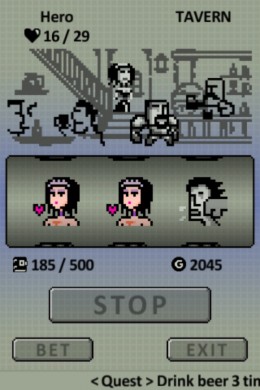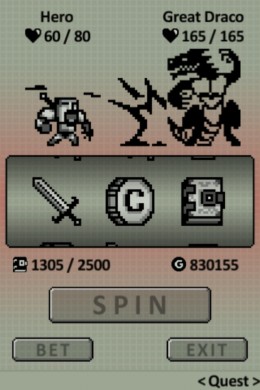![]() While dwindling on consoles, RPGs of all shapes and sizes are flourishing on mobile devices. There have been some truly creative and unique RPGs released in the past few years, and perhaps none is capable of tugging at your heartstrings and pushing you to fight just one more battle than Game Stew Studio‘s new iOS game, Tower of Fortune (ToF) ($1.99).
While dwindling on consoles, RPGs of all shapes and sizes are flourishing on mobile devices. There have been some truly creative and unique RPGs released in the past few years, and perhaps none is capable of tugging at your heartstrings and pushing you to fight just one more battle than Game Stew Studio‘s new iOS game, Tower of Fortune (ToF) ($1.99).
Like Puzzle Quest and Sword & Poker before it, ToF infuses a basic role-playing game with mechanics drawn from a completely different genre entirely—in this case, slot machines.
The premise of ToF is pretty simple. You’re a hero. You’ve a lady to rescue. You need to gather coin, get loot, and defeat evil incarnate. A “game of the year”-winning story, this is not, but the simple framework provides enough context to the game to make it work.
Before you even get to the gameplay, though, you’ll be hard-pressed to ignore ToF’s eye-catching retro art style and ear-pleasing chip tunes. Both the game’s quirky, NES-era visuals and strong selection of catchy music make the game visually and aurally simplistic and yet undeniably charming, like the greatest Gameboy games of yore.
Presentation is all well and good, of course, but how does the game actually play? Surprisingly well. ToF succeeds in blending the requisite RPG features with the mechanics of a slot machine, albeit with only one truly noteworthy quirk.
Currency is central to ToF, and it’s what powers all of the game’s subsequent systems. To progress through the game’s world, you’ll need coin. To battle, you’ll need to spend (and potentially lose) coin. To upgrade your hero, you’ll need coin. To heal after battle, you’ll need coin. To buy items… you get the point.
There are two ways to earn coin in the game: through fairly nonintrusive microtransactions or by fighting monsters. Given that the combat is the star of the show, most will be content to get their hands dirty and earn money the hard way, and it’s not hard to do so willingly as prices aren’t as exorbitant as they are in similar games.
 This is where the game’s slot system comes into play. When you enter combat, you’ll be greeted with a simple one-line, three-reel slot machine. The reels are filled with icons that represent doing damage, taking damage, gaining XP, and gaining coin. Whatever icon appears on the left-most reel determines what happens during the turn, and the more like icons matched, the more significant the effect. In addition, the effect is multiplied by repeat matches, so if you get XP one spin and XP again the next, you’ll get an XP bonus.
This is where the game’s slot system comes into play. When you enter combat, you’ll be greeted with a simple one-line, three-reel slot machine. The reels are filled with icons that represent doing damage, taking damage, gaining XP, and gaining coin. Whatever icon appears on the left-most reel determines what happens during the turn, and the more like icons matched, the more significant the effect. In addition, the effect is multiplied by repeat matches, so if you get XP one spin and XP again the next, you’ll get an XP bonus.
One more level of both gambling and depth is added to the battle system by way of a simple “Bet” button. Prior to a spin, you can bet your coin to enhance the effects of the spin. Every effect is doubled after a bet, so you’ll be crossing your fingers in hopes of avoiding taking damage icons and screaming in joy when you hit a full three-match of XP or coin. This becomes critical as bad guys get harder and have more health.
I’m not much of a gambler, and random elements in games tend to annoy me to no end—here’s looking at you, Crisis Core. But after hours of playing, I’ve found that ToF manages a fine balance between feeling cheated and feeling lucky, and hard battles are nail-biters as a result. As you begin to fight more difficult monsters, the high wrought by a good string of luck and the stomach-sinking disappointment wrought by a bad one make the game quite compelling.
 In practice, the system works surprisingly well. This is largely thanks to the game’s simple loot and upgrade systems, which allow you to upgrade your character periodically with simple items and stat boosts, you can do a decent amount to prepare for battle and tip the tide in your favor.
In practice, the system works surprisingly well. This is largely thanks to the game’s simple loot and upgrade systems, which allow you to upgrade your character periodically with simple items and stat boosts, you can do a decent amount to prepare for battle and tip the tide in your favor.
If there are any complaints to be had, they would revolve around the game’s sense of progression. Progression is a critical component of any RPG: it’s what keeps the genre’s fans playing, even when everything else—from storyline to graphics and beyond—may falter. ToF struggles a little bit in this regard, as progression is too random and too fleeting to feel rewarding in the long run.
Moving through the game from area to area requires paying escalating “unlock” fees. This means that you’ll need to amass a substantial purse. This in-and-of-itself wouldn’t be that bad, but when combined with the game’s rougelike treatment of death, you can find yourself frustrated.
Should you die, you’ll lose all the equipment, levels, and upgrades you earned as you play—you keep only your unspent coin. As a result, some may beat the game in a day while others could theoretically play it indefinitely and never see the end. This near-complete randomness makes it hard to feel any sustained, substantial, and satisfying feelings of progression.
In spite of this issue, though, the game never stops being fun to play. The game’s ability to produce such a wide spectrum of emotional highs and lows is no small feat for a game, and additional elements, like the game’s fun mini-quest system that introduces small objectives that reward XP when completed, do wonders at keeping things fresh.
Ultimately, Tower Of Fortune may not have the progression elements, compelling story, or depth of its meatier RPG brethren, but it has all the stats, levels, loot, triumph, and tragedy a RPG fan needs for on-the-go gaming.


